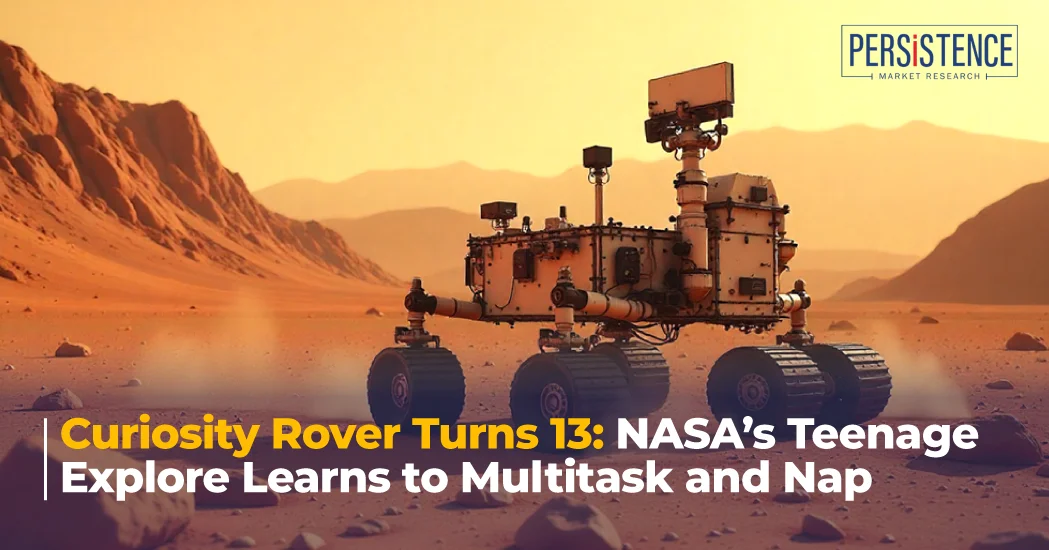- Blog
- Curiosity Rover Turns 13 Nasas Mars Explorer Updates
Curiosity Rover Turns 13: NASA’s Teenage Explore Learns to Multitask and Nap
Published On : 22 Aug 2025
Landing in Gale Crater in August 2012, NASA’s Curiosity rover carried the clear yet bold mandate of uncovering the history of the planet Mars, decipher its geology, and search for signs of habitability. Thirteen years on, the rover shows no signs of lethargy, either in its rugged hardware or in its equally resilient mind. In fact, this “mind” just received one of its most game-changing firmware updates that will enable Curiosity to multitask, conserve energy with self-directed “naps,” and ultimately stretch the limits of its mission. The purpose of the update is not just to extend Curiosity’s lifespan but also to compel us to rethink space mission longevity, autonomy, and the role of software in extraterrestrial exploration.

Powering a Diminishing Battery
At the heart of Curiosity’s endurance is its Multi-Mission Radioisotope Thermoelectric Generator (MMRTG). Fueled by decaying plutonium, the MMRTG though provides steady electricity it gradually loses output year after year. In practice, this means the engineering team at NASA must squeeze more science out of less energy.
The new software update tackles this head-on by allowing subsystems, such as mobility, robotic arm, radio, and imaging, to run in tandem with each other, reducing the time for which the heaters and instruments must stay powered. Instead of passively waiting for queued commands, the rover can now finish tasks earlier and slip into a smart-sleep mode, shutting down until needed again. This is a classic exemplification of efficiency paired with the strongest survival instincts on a lonely planet.
Aiding Multitasking on Mars
When Curiosity first strolling on Mars, safety and extreme caution triumphed everything else, with the rover taking up one task at a time, carefully preprogrammed from Earth. Now, on its thirteenth birthday, it has been trusted with autonomous multitasking. That means Curiosity can drive while relaying data to orbiters, operate its robotic arm mid-journey, and capture images while navigating. The result? Each sol, or Martian day, is now more productive, maximizing scientific return without burning extra power. Even though it is not as advanced as the Perseverance rover’s AI-driven navigation, this leap takes care of the autonomy question, authoritatively showing how even a supposed “teenage rover” can blossom into a smarter, self-reliant explorer.
Software: The Behind-the-Scenes Worker
Probably one of the most underappreciated aspects of space missions is the power of software updates. On Earth, firmware upgrades fix bugs; on Mars, they extend lives of unmanned rovers. This latest software refresh rolled out on Curiosity consists of nearly 180 improvements. Some of the most essential among these include:
- Wheel wear algorithms: Softer driving patterns reduce strain on Curiosity’s already battered wheels.
- Camera workarounds: A jammed Mastcam filter wheel no longer halts imaging, as NASA repurposed the code to keep the panoramic shots coming in uninterrupted.
- Drilling revisions: Updated sampling techniques bypass mechanical hiccups, keeping rock analysis on track.
In short, software-powered adaptation will sustain the productivity of Curiosity long after its physical parts begin showing weariness. With over 22 miles (35 kilometers) already behind it, this rover proves that code can prove to be just as crucial as metal.
A Box Full of Scientific Rewards
Efficiency gains directly impact science. In this case, by spending less time idling, Curiosity can now devote more minutes to sampling rocks, analyzing soils, and scanning the Martian sky. The most recent of its exploratory highlights include the study of boxwork formations, which are lattices of hardened rock indicating ancient groundwater activity, and the discovery of Paposo, a coral-like rock about 5 cm wide. Such finds are crucial in reconstructing the hydrological history of Mars, providing clues to whether the Red Planet could have hosted microbial life. Every watt saved now directly contributes to fueling insights into climate evolution, planetary habitability, and the story of Martian transformation.
A Turning Point in Mission Strategy
Unlike the devices we use on exploring Earth, rovers cannot be retrieved for servicing. Instead, their evolution is contingent on software. This philosophy of treating missions as living, adaptive systems has proven critical to space exploration resilience. In fact, Curiosity’s firmware refresh demonstrates confidence in autonomy such that NASA now trusts its rover to self-manage, efficiency through code, and blueprint for future missions as Perseverance, Europa Clipper, and others of their kind will inherit lessons in software-first longevity. The change in mission strategy is not just about keeping Curiosity alive, it is about entirely rethinking how interplanetary robots will operate in the decades to come.
An Even More Curious Rover
The poetry in this milestone is hard to ignore. Curiosity has been called a teenager because its thirteenth year marks a shift from dependence to responsibility, much like how humans treat their little ones after they hit this age. No longer does every move wait for Earth’s micromanagement; instead, the rover can now decide on its own when to get up, when to work, and when to rest. This is testament to not only technological ingenuity but also trust between humans and machines. In a sense, every firmware line is a thread of mentorship, letting Curiosity carry forward with more wisdom, more efficiency, and more independence.
Thirteen years after touching down on Martian soil, Curiosity is now leveling up. For engineers, the upgrade is proof that spacecraft design must prioritize adaptability. For scientists, it means more samples, images, and data from Gale Crater. And for humanity, it’s a reminder that curiosity, whether human or robotic, thrives best when it can learn, adapt, and endure; in essence, when it has a life of its own.
Industry Report

Request Report Sample
Your privacy is important to us; your data is secure
Contact Us
Latest Reports
-
Piezoresistive Pressure Sensor Market by Sensor Type (Absolute, Gauge, Differential, Sealed), Pressure Range (Low Pressure (<10 kPa), Medium Pressure (10 kPa – 1000 kPa), High Pressure (>1000 kPa)), End-Use Industry (Automotive & Transportation, Industrial Manufacturing, Healthcare, Aerospace & Defense, Electronics) and Regional Analysis for 2026-2033
-
Aquarium Accessories Market by Product Type (Filtration Items, Lights & Hoods, Temperature Control Systems, Others), End-User (Residential, Commercial), Distribution Channel (Online, Offline), and Regional Analysis for 2026-2033
-
Oxygen Therapy Market by Product Type (Compressed Oxygen, Concentrated Oxygen, Liquid Oxygen), Disease (Respiratory Disorder, Cardiovascular Disease, Sleep Apnea, Pneumonia), End-User (Hospitals, Home Healthcare, Clinics), and Regional Analysis for 2026-2033
-
Air Curtains Market by Product Type (Non‑Recirculating, Recirculating, Heated, Others), Airflow Capacity (Up to 500 m³/h, 500–1000 m³/h, 1000–1500 m³/h, Above 1500 m³/h), Application (Commercial, Industrial, Residential, Others), and Regional Analysis for 2026–2033
-
Personalized Stationery Market by Product type (Storage & Filling Products, Paper-Based Products, Drawing & Writing Instruments, Accessories, Bags, Others), Application (Educational Institutes, Corporate Offices, Personal Use, Hospitals, Others), and Regional Analysis for 2026–2033
